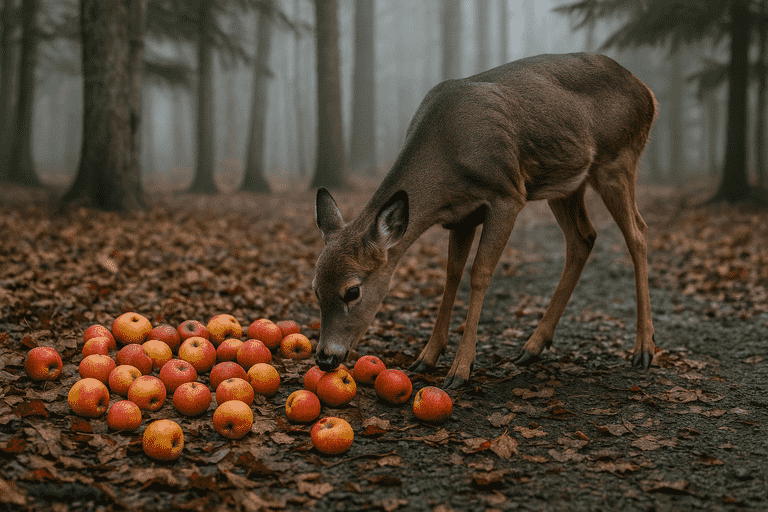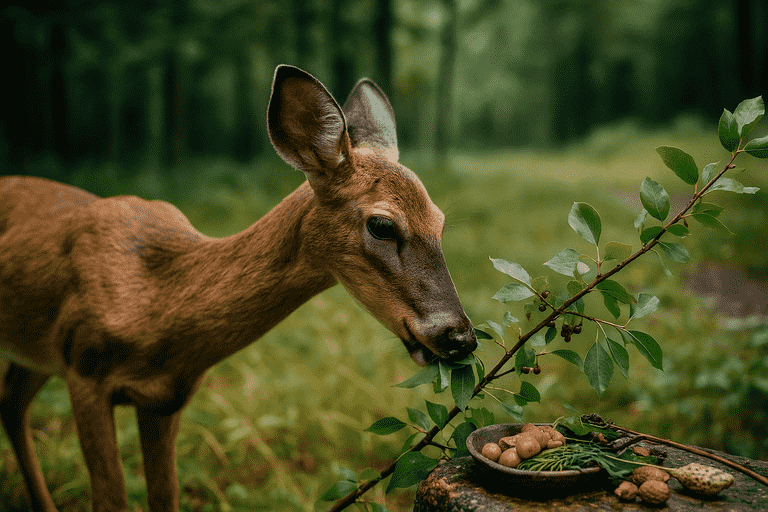Wildlife management experts consistently emphasize how wild deer food plays a critical role in sustaining healthy forest ecosystems. Deer don’t just eat; they influence plant distribution, regeneration, and even insect habitats through their foraging behavior.
In addition, understanding what deer eat in the wild helps prevent habitat degradation. For instance, when food sources become scarce, deer tend to overgraze specific plant species, leading to soil erosion. Therefore, maintaining a natural balance of native plants is vital.
Seasonal Variations in Wild Deer Food Availability
Throughout the year, deer adjust their diet based on what’s available in their environment. In spring and summer, they rely on soft vegetation such as buds, clover, and leaves. However, as colder months approach, their consumption shifts toward woody browse like twigs and bark.
This dietary flexibility helps deer survive various climates, but it also highlights how changes in habitat can dramatically affect access to wild deer food. Therefore, maintaining biodiversity ensures consistent food access year-round.

How Human Activity Disrupts Access to Wild Deer Food
Urban expansion, logging, and agriculture all contribute to the loss of natural foraging grounds. As trees disappear and fields are cleared, deer face increasing difficulty locating adequate food. Consequently, they often venture into suburban areas, increasing vehicle collisions and crop damage.
Wild Food as a Gateway to Self-Reliance and Natural Living
For example, when natural sources of wild deer food vanish, deer may begin feeding on ornamental plants or farm crops. In addition, these disruptions can cause population stress, leading to malnutrition and disease.
Nutritional Composition of Natural Wild Deer Food
Wild deer require a specific blend of nutrients to maintain their health, especially during mating and winter survival periods. Naturally available forage provides protein, fiber, and essential minerals. For instance, acorns supply necessary fats, while grasses offer digestible energy.
Moreover, plant variety plays a key role. Deer that consume a diverse range of wild deer food exhibit stronger immune systems and higher reproductive success. Therefore, preserving habitat variety supports not just survival but long-term species health.

Native Plants That Serve as Primary Wild Deer Food
Deer rely heavily on specific plant species native to their region. These include oak saplings, sumac, wild berries, and goldenrod. Because these plants co-evolved with local wildlife, they offer optimal nutrition and require minimal water or maintenance to thrive.
Wild Turtle Food: A Guide to Nutritional Needs
In addition, planting native flora in conservation areas improves food access. This strategy ensures deer find enough wild deer food without resorting to human settlements, reducing human-wildlife conflict in rural and suburban areas.
How Landowners Can Support the Availability of Wild Deer Food
Property owners who live near forests or natural preserves can make a real difference by managing their land responsibly. For example, avoiding excessive mowing and preserving underbrush encourages plant diversity. In addition, replanting native shrubs and trees strengthens the food chain.
Furthermore, controlled burning and selective thinning promote the regrowth of forage plants. When land is managed with wildlife in mind, the amount and quality of wild deer food increases substantially, benefiting multiple species.

The Role in Predator-Prey Dynamics
Deer serve as prey for wolves, coyotes, and mountain lions. Their population size directly affects predator movement and behavior. If deer lack proper nutrition due to a decrease in wild deer food, their weakened state may increase predation rates and cause ecological imbalance.
Why Wild Squirrel Food Plays a Vital Role in Natural Ecosystems
Therefore, food quality doesn’t just affect deer; it influences the entire food web. For instance, when deer congregate in smaller areas due to food scarcity, predators follow, sometimes clashing with human communities.

Future Conservation Efforts Sustainability
Wildlife organizations are now prioritizing long-term food planning in conservation strategies. For example, some parks are restoring oak savannas and native meadows specifically to bolster wild deer food supplies. These efforts improve not only deer health but also soil and water quality.
Moreover, public education encourages local engagement. Citizens who understand the importance of deer diets are more likely to support zoning laws, rewilding projects, and responsible land development.
Final Thoughts
When we protect and understand wild deer food, we also safeguard the intricate balance of forest life. Healthy deer populations support diverse ecosystems, which in turn benefit humans through cleaner air, better soil, and more resilient natural spaces.
Therefore, anyone interested in nature preservation should begin by looking at what sustains its most iconic species. By prioritizing natural forage, we create a healthier future for all life—two-legged and four.

